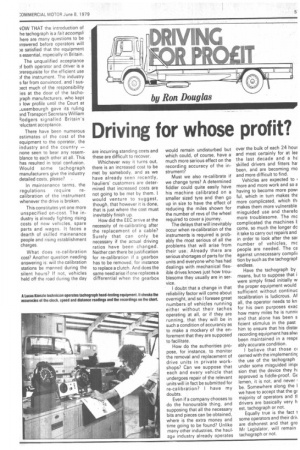Driving for whose profit?
Page 59

If you've noticed an error in this article please click here to report it so we can fix it.
VOW THAT the introduction of he tachograph is a fait accompli here are many questions to be inswered before operators will le satisfied that the equipment s essential, especially in Britain.
The unqualified acceptance if both operator and driver is a )rerequisite for the efficient use yf the instrument. The industry s far from convinced, and I sus)ect much of the responsibility ies at the door of the tachograph manufacturers, who kept 3 low profile until the Court at _uxembourgh gave its ruling 3nd Transport Secretary William Rodgers signalled Britain's -eluctant acceptance There have been numerous estimates of the cost of the equipment to the operator, the industry and the country — none seen to bear any resemblance to each other at all. This has resulted in total confusion. Would some tachograph manufacturers give the industry detailed costs, please? .
In maintenance terms, the
regulations require recalibration of the instrument whenever the drive is broken.
This constitutes yet one more unspecified on-cost. The industry is already fighting rising costs of new vehicles, spare parts and wages. It faces a dearth of skilled mainenance people and rising establishment charges.
What does re-calibration cost? Another question needing answering is will the calibration stations be manned during the silent hours? If not, vehicles held off the road during the day are incurring standing costs and these are difficult to recover.
Whichever way it turns out, there is an increased cost to be met by somebody, and as we have already seen recently, hauliers' customers are determined that increased costs are not going to be met by them. I would venture to suggest, though, that however it is done, that is just where the cost must inevitably finish up.
How did the EEC arrive at the necessity of re-calibrating after the replacement of a cable? Surely that can only be necessary if the actual driving ratios have been changed. Neither can there be justification for re-calibration if a gearbox has to be removed, for instance. to replace a clutch. And does the same need arise if one replaces a differential when the gearbox
would remain undisturbed but which could, of course, have a much more serious effect on the recording accuracy of the instrument?
Must we also re-calibrate if we change tyres? A determined fiddler could quite easily have his machine calibrated on a smaller sized tyre and then go up in size to have the effect of reducing the miles shown for the number of revs of the wheel required to cover a journey.
The delays that will inevitably occur when re-calibration of the instruments is required is prob ably the most serious of all the problems that will arise from their use. Already there are serious shortages of parts for the units and everyone who has had dealings with mechanical flex ible drives knows just how troublesome they usually are in service.
I doubt that a change in that reliability factor will come about overnight, and so I foresee great numbers of vehicles running either without their tachos operating at all, or if they are running, that they will be in such a condition of accurancy as to make a mockery of the enforement that they are supposed to facilitate.
How do the authorities propose, for instance, to monitor the removal and replacement of drive units in private workshops? Can we suppose that each and every vehicle that undergoes repair of the relevant units will in fact be submitted for re-calibration? I have my doubts.
Even if a company chooses to do the honourable thing, and supposing that all the necessary bits and pieces can be obtained, where is the extra money and time going to be found? Unlike many other industries, the haulage industry already operates
over the bulk of each 24 hour and most certainly for at lee the last decade and a hz skilled drivers and fitters ha. been, and are becoming ma and more difficult to find.
Vehicles are expected to I more and more work and so a having to become more pow( ful, which in turn makes thE more complicated, which th makes them more vulnerable misguided use and therefo more troublesome. The mc complicated the machines L come, so much the longer dc it take to carry out repairs and in order to look after the sar number of vehicles, mc people are needed. The ca against unnecessary complii tion by such as the tachograph endless.
Have the tachograph by means, but to suppose that i were simply fitted initially w the proper equipment would sufficient without continuc recalibration is ludicrous. Af all, the operator needs to kn for his own purposes exac how many miles he is runnii and that alone has been s ficient stimulus in the past him to ensure that his distar recording equipment has atm been maintained in a respE ably accurate condition.
I believe that those ci cerned with the implementinc the use of the tachograph under some misguided impi sion that the device they h; approved is fiddle-proof. GE lemen, it is not, and never be. Somewhere along the I we have to accept that the gr majority of operators and tl drivers are basically very h est, tachograph or not.
Equally true is the fact 1 some operators and their dri\ are dishonest and that gro Mr Legislator, will remain tachograph.or not.




















































































































































